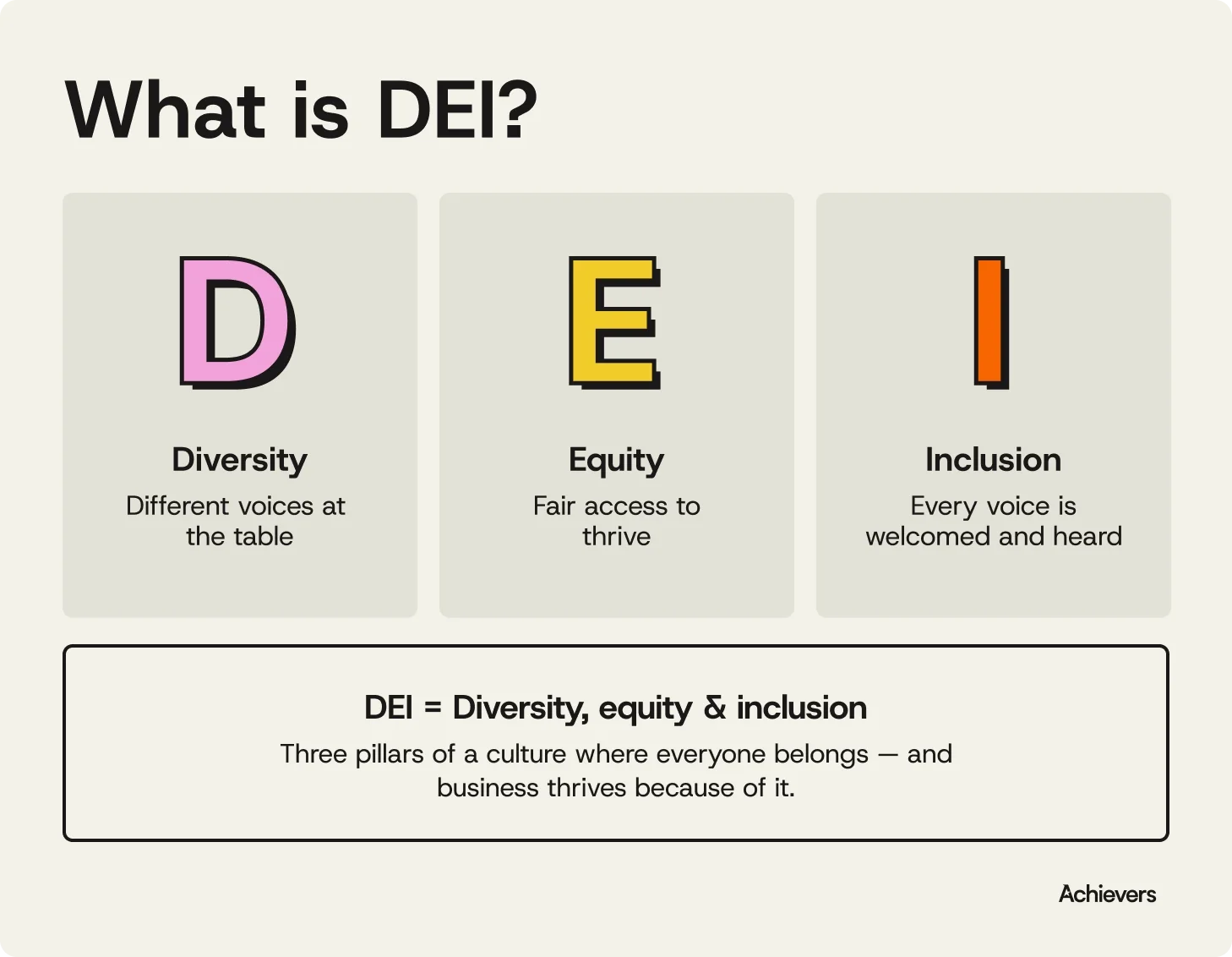Table of contents
The workforce isn’t just changing — it’s rewriting the rules. With Millennials and Gen Z now making up the majority of employees, expectations around diversity, equity, and inclusion (DEI) aren’t just “nice to have.” They’re non-negotiable.
Organizations that want to stay relevant (and profitable) need to move past performative pledges and start embedding DEI into the fabric of their company culture. Not just because it’s the right thing to do — though it is — but because employees who feel seen, heard, and valued are the ones who stick around, show up, and perform.
So let’s unpack what DEI really means in today’s workplace — and how your company can turn good intentions into everyday action (spoiler: It’s not as complicated as it sounds).
Defining the D, the E, and the I (and why they matter more than ever)
Let’s be real: DEI isn’t just another corporate acronym you toss into slide decks. Diversity, equity, and inclusion are the building blocks of a workplace where people actually want to show up, speak up, and stick around. Done right, DEI turns intention into impact — creating cultures where everyone feels like they belong, not just that they’re allowed in the building.
So, what do these terms really mean in practice? Let’s explore them a little further:

D = Diversity
Diversity is all about representation — and not just ticking boxes. It means building teams that reflect a wide range of lived experiences, identities, and perspectives. Generational. Racial. Cognitive. Gender. Cultural. The list goes on — and for good reason. Teams that embrace true diversity don’t just look good on paper. They perform better, too. In fact, diverse teams are 87% better at making decisions — and we’re willing to bet those decisions involve fewer reply-all emails.
E = Equity
Equity is where fairness meets reality. It’s not about giving everyone the same thing — it’s about giving each person what they need to succeed. Equity acknowledges that not everyone starts from the same place and works to level the playing field with inclusive practices, accessible opportunities, and transparent communication. However, a recent study found that 62% of organizations devote little to no resources to DEI initiatives, highlighting a significant gap between intent and action.
I = Inclusion
Inclusion is the secret sauce. It’s what makes diversity stick. Inclusion means creating an environment where every person feels safe, valued, and encouraged to contribute — not just occasionally invited to the table, but handed the mic. And the results speak for themselves: organizations that prioritize inclusivity see a 56% boost in performance and a 37% drop in absenteeism. Why? Because when people feel like they belong, they show up — fully, consistently, and ready to do great work. That’s when the real magic happens.
So, what is DEI, really?
Diversity, equity, and inclusion aren’t standalone initiatives — they’re deeply connected pillars of a thriving workplace. Diversity brings different voices to the table. Equity ensures everyone has what they need to be heard. And inclusion makes sure those voices are welcomed, respected, and empowered to shape the conversation.
Together, DEI creates the kind of culture where people feel like they belong — not in spite of their differences, but because of them. It’s not about optics. It’s about outcomes. And when done right, DEI doesn’t just improve morale — it drives performance, retention, innovation, and trust.
In short: DEI helps companies work smarter by making work better for everyone.
Why DEI isn’t just important — it’s essential
Let’s start with a stat that should make every HR leader sit up straight: 51% of employees are open to leaving their jobs, and for 41% of them, it’s because of a poor workplace culture. Translation? If your organization isn’t actively cultivating a positive, inclusive culture, your best talent might already be halfway out the (virtual) door.
And here’s where DEI comes in — not as a checklist, but as a powerful driver of retention, innovation, and long-term business growth. Companies with high workforce diversity are 72% more likely to see sustained success. So yes, the case for investing in diversity, equity, and inclusion basically writes itself. But let’s break it down anyway.
Recruiting
Want to attract the best and brightest? Cast a wider net. DEI expands your recruiting reach to talent pools filled with new perspectives, skill sets, and lived experiences — the kind that fuel innovation and creative problem-solving. Plus, your employer brand gets a boost: 76% of job seekers say workforce diversity matters when considering a company. DEI isn’t just good ethics — it’s great marketing.
Retention
Getting top talent in the door is one thing. Keeping them is another. When employees feel respected, heard, and supported, they’re far more likely to stick around. A real commitment to DEI helps create a culture where people don’t just survive — they thrive. And that kind of environment is magnetic. It’s also essential for employee well-being, which is increasingly recognized as a cornerstone of long-term engagement and retention.
Business performance
Here’s where things really get interesting. Companies with diverse management teams report 19% higher innovation revenue compared to those with less diverse leadership. Why? Because different perspectives challenge groupthink, spark fresh ideas, and drive better collaboration. The result? Resilient teams that weather change and drive results — even during tough times. Some would call that magic. We call it DEI.
Company culture
Culture eats strategy for breakfast, remember? 94% of employees agree that a healthy workplace culture is vital to business success. A strong DEI foundation helps build that culture — one rooted in fairness, accountability, and belonging. It doesn’t just make people feel good. It makes them want to stay, grow, and go above and beyond.
So, why is DEI important?
Because it touches everything — from hiring and retention to innovation, engagement, and culture. It influences who joins your team, who stays, who speaks up, and who thrives. Ignore it, and you risk losing not just your people, but the ideas, energy, and momentum that drive your business forward. Embrace it, and you’re not just building a better workplace — you’re shaping a workforce that’s more agile, resilient, and ready to take your business anywhere. Even through the weird times. Especially through the weird times.
How to bring DEI to life at work
Building a diverse, equitable, and inclusive workplace doesn’t require a complete overhaul — just a few purposeful steps in the right direction. Here’s a short playbook you can follow:
- Start with hiring: Where are you sourcing candidates? How are you evaluating them? Are your criteria fair, or just familiar? DEI begins by widening the door and removing the bias at the threshold.
- Build connections: Employee resource groups (ERGs) are a great way to foster belonging and give employees a space to share their perspectives — and yes, their honest feedback. ERGs also offer leadership a direct line into the evolving needs of your workforce. Listen. Learn. Adapt. Repeat.
- Recognition matters: When managers regularly acknowledge employees for who they are and what they contribute, it boosts equity, engagement, and trust. A platform that ties recognition to company values reinforces inclusive behaviors — and it works. AWI data shows that monthly recognition drives a 40% boost in engagement and a 25% jump in commitment.
- Keep the feedback loop open: Use surveys and engagement tools to ask meaningful questions about inclusion — then act on the answers. Nothing says “we hear you” like actually doing something with what you’ve heard.
So, how do you make DEI stick?
DEI isn’t one-and-done. It’s not a workshop, a quarterly update, or a page in your onboarding deck. It’s a continuous commitment — one that requires intention, consistency, and the right tools to stick. But when DEI becomes part of your daily culture, something powerful happens: people feel safe to show up, speak up, and contribute in meaningful ways. That’s when belonging takes root. And that’s when your DEI efforts start delivering the results that matter — for your people and your business.
Turn your DEI intentions into impact with Achievers
DEI isn’t a checklist — it’s a mindset shift. And while progress takes work, the payoff is worth it: stronger culture, better engagement, and a workforce that actually wants to stick around.
At Achievers, we make DEI actionable. Our platform is built to amplify the voices that often go unheard — making it easier to recognize inclusive behaviors, reward meaningful contributions, and turn feedback into real change. Whether you’re building your program from the ground up or fine-tuning what’s already in place, we help you embed DEI into everyday moments that matter.
Because when employees feel seen, heard, and valued, they don’t just show up — they show up strong.



